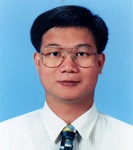
Plenary Lecture
Indirect Frequency Measurement of Cable-Stayed Bridges in Cross Winds

Professor J. D. Yau
Department of Architecture
Tamkang University
Taiwan
E-mail: jdyau@mail.tku.edu.tw
Abstract: In conventional bridge health monitoring, a number of sensors are deployed on the bridge directly for detecting its various dynamic properties. This is so called “direct method”. But the drawbacks of the direct method are: laborious deployment of sensors, time-consuming, and not portable. Following the previous Yang’s works (2004) by using a passing test vehicle as a message receiver of bridge response, which is called “indirect method”, this study regards cross winds as lateral excitational sources to detect the lateral bridge frequencies from the lateral response of the moving test vehicle. To account for the wind-vehicle-bridge interactions in performing dynamic analysis, an iteration-based 3D vehicle-bridge interaction (VBI) finite element method was developed. The whole wind/VBI system is decomposed into two subsystems: the wind-bridge subsystem and the wind-vehicle subsystem. Then the iterative scheme is carried out to compute the interaction response between the two subsystems independently and iterate for removing unbalance forces. The numerical results indicated that the present indirect bridge monitoring is a simple and feasible method to measure the lateral frequency of a long-span bridge in cross winds.
Brief Biography of the Speaker: Dr. J.D. Yau got his Ph.D. from National Taiwan University (NTU) in 1996. After serving as a chair-engineer at the Kuan-Tech Eng Consult Co. in Taiwan (1997-1999), he joined the faculty at TamKang University (TKU, 1999) where he has served as Assistant Professor (1999-2003), Associate Professor (2003-09), and Chair (2004-2007) in the Department of Architecture and Building Technology. In 2010, Dr. Yau became a Professor of TKU, and an Adjunct Professor of Zhejiang University (2011-2017), a Visiting Professor of East China Jiao Tong University in China (2011-2017). He is also a Supervisor of the Chinese Taiwan Association of Wind Engineering (CTAWE, 2014-2018) and Academic chair of Taipei Structure Engineering Association (2016-2018). Dr. Yau has published over 60 referred journal papers and articles. His research area of interest is centered on: 1. Interaction aerodynamics of vehicle-bridge system, 2. Vibration problems of high speed rails, 3. Maglev dynamics of vehicle/guideway interaction
Selected publications (2011~2016):
1. Yang, Y.B., Yau, J.D. (2011), An iterative interacting method for dynamic analysis of the maglev train–guideway/foundation–soil system, Eng Struct, 33, 1013-1024.
2. Yau, J.D. (2012). Lateral vibration control of a low-speed maglev vehicle in cross winds. Wind Struct, 15(3), pp263-283.
3. Kuo, S.R.and Yau, J.D. (2011), A fast and accurate step-by-step solution procedure for direct integration, Intl. J. Struct. Stab. Dyna., 11(3) 473-493.
4. Kuo, S.R., Yau, J.D, and Yang, Y.B. (2012), A robust time-integration algorithm for solving nonlinear dynamic problems with large rotations and displacements, Intl. J. Struct. Stab. Dyna., 12(6) 1250051 (24pages).
5. Yau, J.D. (2013) Wave passage effects on the seismic response of a maglev vehicle moving on multi-span guideway. Latin Amer J Solids Struct, 10(5) 981 – 1000.
6. Yau, J.D., Fryba, L (2015), A quasi-vehicle/bridge interaction model for high speed railways, J Mech., 31, 217-225.
7. Yang, Y.B., Yau, J.D. (2015), Vertical and pitching resonance of train cars moving